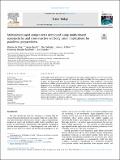Multiplexed rapid antigen tests developed using multicolored nanoparticles and cross-reactive antibody pairs: Implications for pandemic preparedness
Author(s)
de Puig, Helena; Bosch, Irene; Salcedo, Nol; Collins, James J; Hamad-Schifferli, Kimberly; Gehrke, Lee; ... Show more Show less
DownloadPublished version (5.000Mb)
Publisher Policy
Publisher Policy
Article is made available in accordance with the publisher's policy and may be subject to US copyright law. Please refer to the publisher's site for terms of use.
Terms of use
Metadata
Show full item recordAbstract
Global public health infrastructure is unprepared for emerging pathogen epidemics, in part because diagnostic tests are not developed in advance. The recent Zika, Ebola, and SARS-CoV-2 virus epidemics are cases in point. We demonstrate here that multicolored gold nanoparticles, when coupled to cross-reactive monoclonal antibody pairs generated from a single immunization regimen, can be used to create multiple diagnostics that specifically detect and distinguish related viruses. The multiplex approach for specific detection centers on immunochromatography with pairs of antibody-conjugated red and blue gold nanoparticles, coupled with clustering algorithms to detect and distinguish related pathogens. Cross-reactive antibodies were used to develop rapid tests for i) Dengue virus serotypes 1-4, ii) Zika virus, iii) Ebola and Marburg viruses, and iv) SARS-CoV and SARS-CoV-2 viruses. Multiplexed rapid antigen tests based on multicolored nanoparticles and cross-reactive antibodies and can be developed prospectively at low cost to improve preparedness for epidemic outbreaks.
Date issued
2022-12Department
Massachusetts Institute of Technology. Department of Biological EngineeringJournal
Nano Today
Publisher
Elsevier BV
Citation
de Puig, Helena, Bosch, Irene, Salcedo, Nol, Collins, James J, Hamad-Schifferli, Kimberly et al. 2022. "Multiplexed rapid antigen tests developed using multicolored nanoparticles and cross-reactive antibody pairs: Implications for pandemic preparedness." Nano Today, 47.
Version: Final published version